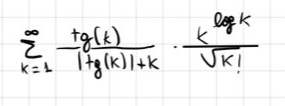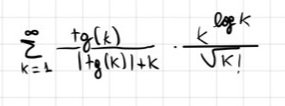You are using an out of date browser. It may not display this or other websites correctly.
You should upgrade or use an alternative browser.
You should upgrade or use an alternative browser.
Convergence of a series with tangent
- Thread starter Aelx
- Start date
D
Deleted member 4993
Guest
What are the convergence test that you have been introduced to in your class?Hi everyone, I'm really struggling with this series.
I have to check if it converges (absolutely or not).
Thank you very much.
View attachment 32830
Please show us what you have tried and exactly where you are stuck.
Please follow the rules of posting in this forum, as enunciated at:
Please share your work/thoughts about this problem

mmm4444bot
Super Moderator
- Joined
- Oct 6, 2005
- Messages
- 10,958
Hello. Please confirm the following interpretation.
\(\displaystyle \sum_{k=1}^{\infty} \frac{\text{tg}(k)}{\;|\text{tg}(k)| + k\;} \cdot \frac{k^{\log(k)}}{\sqrt{k}\;!}\)
What is [imath]\text{tg}(k)[/imath] ?
?
[imath]\;[/imath]
I am actually an aerospace engineer passionate about math. I was helping a Calc 1 student to prepare the exam and found this hard exercise I could not solve. Everything is allowed here as long the convergence is proven/disproven.What are the convergence test that you have been introduced to in your class?
Please show us what you have tried and exactly where you are stuck.
Please follow the rules of posting in this forum, as enunciated at:
Please share your work/thoughts about this problem
View attachment 32831
I started with checking the cauchy necessary condition for convergence by taking the limit of the sequence but the term with tan(n) makes it really hard to handle the function.
Last edited:
tg(k) is tan(k)
Hello. Please confirm the following interpretation.
\(\displaystyle \sum_{k=1}^{\infty} \frac{\text{tg}(k)}{\;|\text{tg}(k)| + k\;} \cdot \frac{k^{\log(k)}}{\sqrt{k}\;!}\)
What is [imath]\text{tg}(k)[/imath] ?
?
[imath]\;[/imath]
Cubist
Senior Member
- Joined
- Oct 29, 2019
- Messages
- 1,699
Also, @Aelx , factorial doesn't work for non-integers, therefore is this correct...
\(\displaystyle \sum_{k=1}^{\infty} \frac{\tan(k)}{\;|\tan(k)| + k\;} \cdot \frac{k^{\log(k)}}{\sqrt{(k!)}}\)
Try dividing the numerator and denominator of the left hand fraction by tan (you may need to consider the two cases tan(k)≥0 and tan(k)<0 separately).
\(\displaystyle \sum_{k=1}^{\infty} \frac{\tan(k)}{\;|\tan(k)| + k\;} \cdot \frac{k^{\log(k)}}{\sqrt{(k!)}}\)
...but the term with tan(n) makes it really hard to handle the function.
Try dividing the numerator and denominator of the left hand fraction by tan (you may need to consider the two cases tan(k)≥0 and tan(k)<0 separately).
Thanks for the advice! Ok I will ask the student I was helping about the factorial, it is possibile to extend the factorial to non integers thorugh the gamma function, but i don't know if this is the case.Also, @Aelx , factorial doesn't work for non-integers, therefore is this correct...
\(\displaystyle \sum_{k=1}^{\infty} \frac{\tan(k)}{\;|\tan(k)| + k\;} \cdot \frac{k^{\log(k)}}{\sqrt{(k!)}}\)
Try dividing the numerator and denominator of the left hand fraction by tan (you may need to consider the two cases tan(k)≥0 and tan(k)<0 separately).
Dividing by tan gives as a result 1+k/tan(k) on the denominator, which is pretty hard to handle when k approaches infinity. I do not think the limit even exists..
Cubist
Senior Member
- Joined
- Oct 29, 2019
- Messages
- 1,699
I probably gave too much advice. When you pass this on to the calc 1 student please try to be more subtle. If they can do most of the work themselves then they will improve faster.Try dividing the numerator and denominator of the left hand fraction by tan (you may need to consider the two cases tan(k)≥0 and tan(k)<0 separately).
Note that actually you need to consider the possibility that tan(k)=0 separately. Why?
You could even divide through by something else initially (instead of tan(k)) to reduce the amount of writing that will be required - can you figure out what?
I am sorry but I struggle to follow you. I didn't even understand how dividing and multiplying by tan(k) may help with the exercise. Could you be more precise?
I personally find this exercise really different from anything I have ever seen during my studies and years of experience in tutoring calc students.
I personally find this exercise really different from anything I have ever seen during my studies and years of experience in tutoring calc students.
I probably gave too much advice. When you pass this on to the calc 1 student please try to be more subtle. If they can do most of the work themselves then they will improve faster.
Note that actually you need to consider the possibility that tan(k)=0 separately. Why?
You could even divide through by something else initially (instead of tan(k)) to reduce the amount of writing that will be required - can you figure out what?
Steven G
Elite Member
- Joined
- Dec 30, 2014
- Messages
- 14,603
@Cubist,Also, @Aelx , factorial doesn't work for non-integers, therefore is this correct...
\(\displaystyle \sum_{k=1}^{\infty} \frac{\tan(k)}{\;|\tan(k)| + k\;} \cdot \frac{k^{\log(k)}}{\sqrt{(k!)}}\)
I am missing your point about factorials. We are summing over the integers, so why the comment that we can only compute factorials of integers.
Thanks,
Steven
Cubist
Senior Member
- Joined
- Oct 29, 2019
- Messages
- 1,699
@Cubist,
I am missing your point about factorials. We are summing over the integers, so why the comment that we can only compute factorials of integers.
Thanks,
Steven
In the original picture the square root sign doesn't quite extend over the factorial symbol IMO, like this...
\(\displaystyle \sqrt{k}\,! = \left(\sqrt{k}\right)!\)
Of course when [imath]k=2 \text{ then } \left(\sqrt{k}\right)! = (\sqrt{2})\,! \approx 1.41421\,! [/imath] and this isn't allowed. I guess we could switch to using the gamma function. However, this seems more likely to be the intended question...
\(\displaystyle \sqrt{k\;!\;}=\sqrt{(k\;!)}\)
I confirm that the factorial is insider the squadre rootIn the original picture the square root sign doesn't quite extend over the factorial symbol IMO, like this...
\(\displaystyle \sqrt{k}\,! = \left(\sqrt{k}\right)!\)
Of course when [imath]k=2 \text{ then } \left(\sqrt{k}\right)! = (\sqrt{2})\,! \approx 1.41421\,! [/imath] and this isn't allowed. I guess we could switch to using the gamma function. However, this seems more likely to be the intended question...
\(\displaystyle \sqrt{k\;!\;}=\sqrt{(k\;!)}\)
Cubist
Senior Member
- Joined
- Oct 29, 2019
- Messages
- 1,699
Thanks for the advice! Ok I will ask the student I was helping about the factorial, it is possibile to extend the factorial to non integers thorugh the gamma function, but i don't know if this is the case.
Dividing by tan gives as a result 1+k/tan(k) on the denominator, which is pretty hard to handle when k approaches infinity. I do not think the limit even exists..
So, with the left hand fraction, we have the following...
When tan(k)>0 then \(\displaystyle \lim_{k\to\infty}\frac{1}{1+\frac{k}{\tan(k)} }\)=?
...and I was thinking that the above tends towards zero because 1/tan(k) must be finite (since k can't be a multiple of pi/2). However, you've made me think that this argument may be flawed.
Here's a graph of this fraction (using a continuous variable x instead of discrete k)...

There are an infinite number of spikes that all peak at 1, they become less wide at the base as x increases. The spikes occur at pi*(1/2+n) for integer values of n. Therefore the peaks can't exactly coincide with k because pi is irrational. However there will be lots of places where the peak almost coincides and this is probably enough to cause the limit to be undefined
Sorry for misleading you - I'll go and spend some time in the corner ?
Thank you very much for your answer. This is actually really helpful since if the term with tan is bounded between 0 and 1 we can just prove the convergence of the series [math]\sum^{\infty}_{k=1} \frac{k^{log(k)}}{\sqrt{k!}}[/math].So, with the left hand fraction, we have the following...
When tan(k)>0 then \(\displaystyle \lim_{k\to\infty}\frac{1}{1+\frac{k}{\tan(k)} }\)=?
...and I was thinking that the above tends towards zero because 1/tan(k) must be finite (since k can't be a multiple of pi/2). However, you've made me think that this argument may be flawed.
Here's a graph of this fraction (using a continuous variable x instead of discrete k)...
View attachment 32844
There are an infinite number of spikes that all peak at 1, they become less wide at the base as x increases. The spikes occur at pi*(1/2+n) for integer values of n. Therefore the peaks can't exactly coincide with k because pi is irrational. However there will be lots of places where the peak almost coincides and this is probably enough to cause the limit to be undefined
Sorry for misleading you - I'll go and spend some time in the corner ?
However, is there a rigorous way to prove the boundedness of [math]\frac{tan(k)}{|tan(k)|+k}[/math]? And If so, could you help me with that ? Thank you very much!
Cubist
Senior Member
- Joined
- Oct 29, 2019
- Messages
- 1,699
You're welcome. Here's a continuous graph of the right hand fraction (using the gamma function)...Thank you very much for your answer. This is actually really helpful since if the term with tan is bounded between 0 and 1 we can just prove the convergence of the series [math]\sum^{\infty}_{k=1} \frac{k^{log(k)}}{\sqrt{k!}}[/math].

...looks like it tends to 0
k/tan(k) must be between 0 and +∞ since we're considering the case tan(k)>0 (and k>0). Therefore the bounds ofHowever, is there a rigorous way to prove the boundedness of [math]\frac{tan(k)}{|tan(k)|+k}[/math]? And If so, could you help me with that ? Thank you very much!
\(\displaystyle \frac{1}{1+\frac{k}{\tan(k)}}\)
ought to be fairly easy,
I'll leave it for you to consider what the fraction simplifies to in the case that tan(k)<0.

